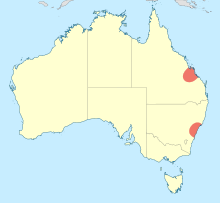Archaeophya adamsi
| Horned urfly | |
|---|---|
| Scientific classification | |
| Kingdom: | Animalia |
| Clade: | Euarthropoda |
| Class: | Insecta |
| Order: | Odonata |
| Infraorder: | Anisoptera |
| Family: | Gomphomacromiidae |
| Genus: | Archaeophya |
| Species: | A. adamsi |
| Binomial name | |
| Archaeophya adamsi | |
 | |
Archaeophya adamsi, commonly known as Adam's emerald dragonfly or horned urfly, is a species of dragonfly belonging to the family Gomphomacromiidae.[2] This is an Australian endemic and one of the rarest dragonflies in the country. It breeds in rivers and streams in coastal areas of Queensland and New South Wales.[3]
Nymphs of this species grow to 23 mm in length and live among rocks and detritus along stream margins. They can be identified by the distinctive two-lobed frontal plate on the head. The nymph lives for around 7 years. The adult is a fairly large and robust dragonfly, blackish brown with narrow yellow rings. The adult probably only lives for a few months.
Gallery
.jpg) Female wings
Female wings.jpg) Male wings
Male wings
Note
There is uncertainty about which family Archaeophya adamsi best belongs to: Gomphomacromiidae,[2] Synthemistidae,[4] or Corduliidae.[5]
References
| Wikimedia Commons has media related to Archaeophya adamsi. |
- ↑ Fraser, F.C. (1959). "New genera and species of Odonata from Australia in the Dobson Collection". The Australian Zoologist. 12: 352–361 [355] – via Biodiversity Heritage Library.
- 1 2 Theischinger, Günther; Hawking, John (2006). The Complete Field Guide to Dragonflies of Australia. Collingwood, Victoria, Australia: CSIRO Publishing. p. 220. ISBN 978 0 64309 073 6.
- ↑ Theischinger, Gunther; Endersby, Ian (2009). Identification Guide to the Australian Odonata (PDF). Department of Environment, Climate Change and Water NSW. p. 192. ISBN 978 1 74232 475 3.
- ↑ Schorr, Martin; Paulson, Dennis. "World Odonata List". Slater Museum of Natural History. University of Puget Sound. Retrieved 29 March 2017.
- ↑ "Archaeophya". Wikispecies. 2006. Retrieved 29 March 2017.
- "Australian Faunal Directory". DSEWPaC. Retrieved 26 January 2011.
- "Threatened fish and marine vegetation". Industry & Investment NSW. Archived from the original on 24 July 2008. Retrieved 26 January 2011.